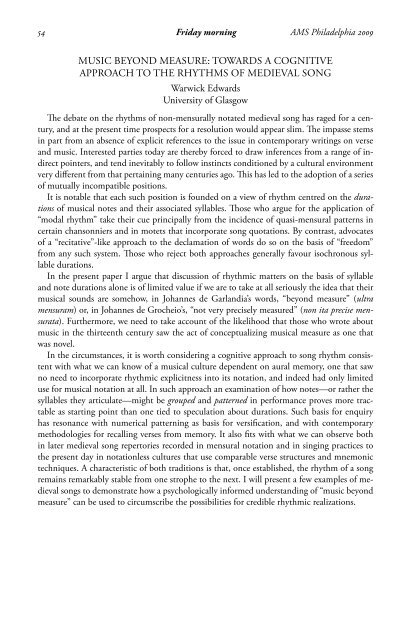AMS Philadelphia 2009 Abstracts - American Musicological Society
AMS Philadelphia 2009 Abstracts - American Musicological Society
AMS Philadelphia 2009 Abstracts - American Musicological Society
Create successful ePaper yourself
Turn your PDF publications into a flip-book with our unique Google optimized e-Paper software.
54 Friday morning <strong>AMS</strong> <strong>Philadelphia</strong> <strong>2009</strong><br />
MUSIC BEYOND MEASURE: TOWARDS A COGNITIVE<br />
APPROACH TO THE RHYTHMS OF MEDIEVAL SONG<br />
Warwick Edwards<br />
University of Glasgow<br />
The debate on the rhythms of non-mensurally notated medieval song has raged for a century,<br />
and at the present time prospects for a resolution would appear slim. The impasse stems<br />
in part from an absence of explicit references to the issue in contemporary writings on verse<br />
and music. Interested parties today are thereby forced to draw inferences from a range of indirect<br />
pointers, and tend inevitably to follow instincts conditioned by a cultural environment<br />
very different from that pertaining many centuries ago. This has led to the adoption of a series<br />
of mutually incompatible positions.<br />
It is notable that each such position is founded on a view of rhythm centred on the durations<br />
of musical notes and their associated syllables. Those who argue for the application of<br />
“modal rhythm” take their cue principally from the incidence of quasi-mensural patterns in<br />
certain chansonniers and in motets that incorporate song quotations. By contrast, advocates<br />
of a “recitative”-like approach to the declamation of words do so on the basis of “freedom”<br />
from any such system. Those who reject both approaches generally favour isochronous syllable<br />
durations.<br />
In the present paper I argue that discussion of rhythmic matters on the basis of syllable<br />
and note durations alone is of limited value if we are to take at all seriously the idea that their<br />
musical sounds are somehow, in Johannes de Garlandia’s words, “beyond measure” (ultra<br />
mensuram) or, in Johannes de Grocheio’s, “not very precisely measured” (non ita precise mensurata).<br />
Furthermore, we need to take account of the likelihood that those who wrote about<br />
music in the thirteenth century saw the act of conceptualizing musical measure as one that<br />
was novel.<br />
In the circumstances, it is worth considering a cognitive approach to song rhythm consistent<br />
with what we can know of a musical culture dependent on aural memory, one that saw<br />
no need to incorporate rhythmic explicitness into its notation, and indeed had only limited<br />
use for musical notation at all. In such approach an examination of how notes—or rather the<br />
syllables they articulate—might be grouped and patterned in performance proves more tractable<br />
as starting point than one tied to speculation about durations. Such basis for enquiry<br />
has resonance with numerical patterning as basis for versification, and with contemporary<br />
methodologies for recalling verses from memory. It also fits with what we can observe both<br />
in later medieval song repertories recorded in mensural notation and in singing practices to<br />
the present day in notationless cultures that use comparable verse structures and mnemonic<br />
techniques. A characteristic of both traditions is that, once established, the rhythm of a song<br />
remains remarkably stable from one strophe to the next. I will present a few examples of medieval<br />
songs to demonstrate how a psychologically informed understanding of “music beyond<br />
measure” can be used to circumscribe the possibilities for credible rhythmic realizations.










